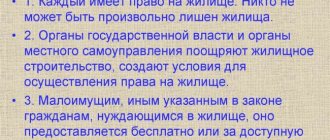Updated July 20, 2021
Hello, dear readers of the KtoNaNovenkogo.ru blog. There is such a stable expression “form of ownership”. Its meaning is understandable only to people theoretically or practically involved in business, law, and economics.
Let us today understand what a form of ownership is, what types of forms exist.
What is this
The concept means the relationship between distribution and appropriation. Characterizes the right of a subject (legal entity, individual or group of persons) to dispose of its property rights, having certain goals.
Today, in order to determine which 4 main forms, types and subtypes of property are enshrined in the state, you can study the provisions in civil law, data in Russian legislation regarding the scheme and special specified codes, and also study the provisions provided for in the Constitution of the Russian Federation.
Concept of property and property rights
What is property ?
This is the ownership of things by certain persons, as well as the relationships that arise in connection with the ownership of property. That is, property is both a legal and an economic category. Legal ownership is the right to own things. Consists of the right to own, use and dispose of one’s property.
Property as a civil law institution is a set of legal norms that are aimed at regulating economic property relations using civil law methods.
Property in economics is social relations within the framework of ownership, division and redistribution of property objects. What is important is the actual relationship - who really controls the property and makes decisions about its use, disposes of it, and not the formal right according to documents.
The economic content of property is revealed through ownership, management and control.
Property is a basic economic institution that has existed since people first had things and such concepts as “mine” and “someone else’s.”
We have learned the basic definitions of property, now let's move on to its types.
Varieties
Society cannot exist without any variety of personal or social material values. The question of how they are distributed is relevant for many.
The ownership of material assets is determined in compliance with legal requirements. The law recognizes the existence of equal management conditions based on various selection criteria. Therefore, it is required to know what types and organizational forms of ownership there are, what property relationships exist among organizations, what rules exist in the Russian Federation, to what extent they are recognized as correct in modern Russia and what features exist in the provisions of the Russian Federation.
A Russian citizen can have legal ownership in the Russian Federation and be protected by law in his rights to material assets on the basis of existing legal norms. The norms are subject to the form of ownership of a private individual or organization of a legal entity, be it an LLC, a representative office of a limited liability company, a joint stock company, a state federal company or another owner of an object or objects, which are by definition.
In this regard, the Civil Code of the Russian Federation classifies 4 types of property and identifies the main managers.
State
The copyright owner is the Russian Federation. All results of labor obtained during exploitation belong exclusively to the state.
An important role in the country’s economy means:
- The need for this type is due to those industries where private business cannot exist. This is, for example, the energy supply sector or railway transport.
- The state type is characteristic of the production of public goods. These are the most important areas that include the defense capability of the state.
- Enterprises that were nationalized during the period of economic restructuring are also included.
A distinctive feature is the form of losing to private ownership in relation to economic efficiency indicators. In the case of state ownership, the interest in control is lower.
Municipal
Based on Article 8 of the Constitution of the Russian Federation, the municipal type of ownership is characterized as an independent category and is not considered state-owned. This method of management is distinguished by a specific order of ownership. The right to dispose of property is given to self-government bodies, since this right is the result of the will and interests of the local population.
Municipal ownership is considered to be the ownership of urban property, rural property and ownership of other municipal entities. Municipal assets are taken into management on the basis of the procedure established in Part 2 of Article 125 of the Civil Code of the Russian Federation. According to the regulations, the right to dispose of structures is given to local officials. In some cases, the population receives this right.
Property of a local nature is targeted. This is the basis for its characteristic aspects, operational methods, and features.
Municipal type of ownership is required to solve the following problems:
- To quickly resolve issues at the regional level.
- To solve the problems set by the state and government to local authorities.
- So that local governments can fully function.
Private
The single individual private type of ownership, given the 3 types of ownership, additionally includes the partnership and corporate varieties, which together are inferior to the state form of ownership when it comes to determining the included types.
The type of management distinguishes two main types: individual and public. Each type corresponds to legally justified subcategories that have legal characteristics. Their detailed description is contained in the Civil Code of the Russian Federation.
In turn, the individual variety is divided into the following types:
- A type of unity when all benefits belong to a single citizen who has the right to attract hired workers.
- Type of partnership , characteristic of an association of individuals, for the purpose of conducting business activities, maintaining industrial relations, which corresponds to the type and form of ownership in Russia.
- Type of cooperative . Persons who sell free shares and create capital.
The main social species is characterized by several subspecies:
- Collective. When management rights are equally divided among employees.
- State. When a city or town owns the property.
- Nationwide. If the values belong to state residents. For example, museums or memorial sites.
- Combined. An entity created by combining different types of property.
It is also important to know about the joint and shared types of management available to each person. The Russian Federation recognizes various types of management, following the forms of ownership, including the property of an enterprise in Russia may belong to private individuals living in the Russian Federation, when it can be distributed among them in equal shares under equal conditions.
Public
The owner and manager is society, designated as a collective subject.
The municipal type of ownership, public and corporate represent the organizational and legal form for each type of property and when it concerns public property separately. This variety represents three types of property ownership:
- State. The internal activities of the country are indicated here. Carrying out nationalization, construction of buildings and structures using federal budget funds.
- Collective. Affiliation with public organizations, churches, parties.
- Municipal. The property is managed by local authorities.
Community Fund - Examples
Public associations are an example of independent, voluntary, non-profit institutions. They are created by citizens who unite to achieve a common goal or perform a specific task.
A community foundation is a type of non-profit foundation. It is a form of public association, but it does not have membership. The Foundation sets itself a specific goal, forms a property base that includes voluntary contributions and other income that does not violate the law. This property is used to achieve the goal set by the association.
The founders of the fund transfer a certain share of property to the association. It becomes his property and can be used exclusively for the purposes specified in the charter. Neither the founder nor the managers have the right to spend these funds for personal interest or the acquisition of things into private ownership.
It is allowed to conduct entrepreneurial activity if it helps to achieve a socially useful goal, which became the basis for the creation of the fund. Registration of business entities and participation in them is also allowed. Why is a civil movement-fund organized?
- In the near future, an industrial, environmental, man-made disaster, natural disaster, or accident may occur. The Foundation prepares the population, informs about possible ways to overcome the consequences, and tries to prevent misfortune.
- In every country there are citizens who are unable to defend their legal right or interest due to disability, social or financial status, or status. A fund is organized that supports a certain category of people, for example, a fund to support single mothers or an organization to help the homeless.
- A natural disaster occurred with dire consequences. Activists gather with the goal of financially supporting the victims, providing them with housing, and ensuring the fulfillment of their legal rights. Other tasks are also possible - the fund helps migrants, refugees and other people in need.
- There are associations that protect fathers, children, mothers. They also fight for family values, international peace, and friendship of peoples. Their tasks may include stopping national, religious, and social confrontation.
- The foundations protect and support nature reserves, historical monuments, cultural centers, religious buildings and other objects significant for the country.
- The objectives of the association include caring for the environment, wildlife, protection and support, campaigning against the exploitation of animals in circuses, etc.
- The spread of sports in the country, support for a healthy lifestyle, and the fight against drug addiction are another common area.
- Supporting the cultural, educational, scientific, spiritual sector, stimulating the personal development of the country's citizens by holding events, providing material and social assistance.
- Providing assistance to healthcare and preventive institutions.
- There are funds to help young mothers, single mothers, pensioners, combatants and others.
A striking example is the public association that was created by actresses of the Russian Federation in 2006. They called it the Gift of Life Foundation. The goal of the foundation is to provide assistance to children suffering from serious illnesses.
Main differences
The name of the legal form of ownership (state, private or legal entity) contains answers to questions, including what types there are according to the all-Russian classifier OKOPF, what is the difference with OKFS.
In all the stated provisions, differences between owners are seen. These differences are encrypted in codes. Each code according to the all-Russian classifier has its own number and together all codes represent a list of forms of ownership recorded in the Civil Code of the Russian Federation, which is access to data on a particular organization, for example, an LLC with the ability to be determined in the OKFS by TIN online.
Private, public, and state ownership of valuable and material assets are divided into opposite concepts. The peculiarities of state, municipal form (MAU) or private property in the Russian Federation can be found according to the legislation of the Russian Federation.
Accordingly, there are a lot of differences between the above concepts of legal ownership. The list of main differences includes:
- Freedom to own.
- Division of financial responsibility.
- The difference is in behavior control.
- Commensurability of interests.
- Target directions.
What documents confirm the right to real estate
When purchasing real estate, each person receives the appropriate papers. Documents are divided into:
- technical;
- establishing rights.
Until 2021, it was necessary to obtain a certificate of title to confirm ownership of the property.
Documents evidencing the right of ownership of housing
This could be done only after receiving a technical passport (issued by BTI employees after assessing the housing) and one of the title documents (purchase agreement, etc.).
Mixed form
A mixed or, in other words, joint form of ownership corresponds to combined rights; this largely determines its form of ownership.
To support certain activities of enterprises of various types, the state allocates resources to them. In such conditions of cooperation, the state and the enterprise receive their share of the profits.
We can also recall the housing issue. The forms of ownership of the housing stock are denoted by civil law, and if one is guided by this law, the legislation of the Russian Federation recognizes the following types of funds: private, state, municipal.
In the Russian Federation, the following types of land ownership are being implemented: state federal, state regional, municipal, private.
How can you purchase private housing?
A person has many options for obtaining home ownership. The most common is to purchase an apartment from the developer or the owner. The following methods can also be distinguished:
- Privatization of municipal housing. If a person lives in a municipal apartment that was received before 2005, then he has the opportunity to privatize it.
- Inheriting housing.
- Participation in housing cooperatives and kindergartens.
Purchasing individual housing
People most often purchase an apartment through participation in a shared participation agreement or through a regular purchase and sale agreement.
Property liability
A private individual has to bear all the costs associated with the property he owns. A co-owner of public property is a less interested subject; he feels less responsibility. For example, there was a strong wind that broke the glass in the house. The average citizen will have to pay for new glass himself. Not inserting it is not in the best interests of the person. If glass is broken in a public building, none of the members of society will feel responsible for themselves. The decision to install new glass will be made by the entire society or a specially authorized body.
Public institution - examples
A public institution is a type of public association. It has no membership and sets itself the goal of providing certain services to obtain a certain result. The employees of the institution are interested in this result; they are stated in the charter. This is a legal entity that exists on a theoretical level. Official registration of a public institution is possible only through a court decision.
Example: public institution “Scientific Information Center Soyuz”. There is no membership, the main task is to study the country's historical monuments in order to expand knowledge about the period of political repression in the Soviet Union.
Control
A private owner always wants to know about all the actions performed by the involved persons in relation to his property. Co-owners of public assets are not so interested in this.
For example, some structure is an object of collective property. A foreman was selected to carry out the repairs and became an external manager. He, in turn, brought a team to carry out the necessary work. No member of the society is responsible for quality control of repair activities. Accordingly, monitoring of the progress of work is not carried out at full capacity. As a result, the repair may not be as high quality as if it had been carried out by the same team, but in a private house.
Actual problems
One of them today is considered to be ensuring effective management of public property. Often, due to the limited interests of officials, economic development slows down significantly. For example, a citizen holds the position of administrator in state media. He is not particularly interested in introducing new technologies, since he will not receive any personal profit from it. Of course, in order to maintain his salary and prevent sanctions from being applied to him for improper performance of his duties, he will carry out the assigned tasks.
The extent of the lack of public property is directly dependent on status. The more people are responsible, the less individual responsibility there is.
For example, the building of a municipal preschool educational institution fell into disrepair and was transferred to the “demolition” category. The head of the institution will wait for a transfer to another kindergarten or will look for work on his own. At the same time, he will care little about the fate of the children. A completely different attitude to the problem will be if the kindergarten is private. Its owner will do everything possible to find premises and will assure parents that the problem will soon be resolved.
Ineffective management, unfortunately, is not the only problem. It is not uncommon for officials to use public property to satisfy their personal needs. Such actions cause significant damage to the economy.
List of classifier positions by ascending codes
| Code | Name |
| 10 | Russian property |
| 11 | State property |
| 12 | Federal property |
| 13 | Property of subjects of the Russian Federation |
| 14 | Municipal property |
| 15 | Property of public and religious organizations (associations) |
| 16 | Private property |
| 17 | Mixed Russian ownership |
| 18 | Property of Russian citizens permanently residing abroad |
| 19 | Property of consumer cooperation |
| 20 | Foreign ownership |
| 21 | Property of international organizations |
| 22 | Property of foreign countries |
| 23 | Property of foreign legal entities |
| 24 | Property of foreign citizens and stateless persons |
| 27 | Mixed foreign ownership |
| 30 | Joint Russian and foreign ownership |
| 31 | Joint federal and foreign ownership |
| 32 | Joint ownership of subjects of the Russian Federation and foreign ownership |
| 33 | Joint municipal and foreign ownership |
| 34 | Joint private and foreign ownership |
| 35 | Joint ownership of public and religious organizations (associations) and foreign ownership |
| 40 | Mixed Russian ownership with a share of state ownership |
| 41 | Mixed Russian ownership with a share of federal ownership |
| 42 | Mixed Russian ownership with shares of ownership of constituent entities of the Russian Federation |
| 43 | Mixed Russian property with shares of federal property and property of constituent entities of the Russian Federation |
| 49 | Other mixed Russian property |
| 50 | Property of charitable organizations |
| 51 | Property of political public associations |
| 52 | Property of trade unions |
| 53 | Property of public associations |
| 54 | Property of religious associations |
| 61 | Property of public corporations |
Balancing interests
A private owner can choose what to produce, how to use his property, and what to invest in it. For example, a citizen can plant a tree in his garden, because it is in his interests - he wants to harvest. Participants in collective property are not so interested in producing anything for society, since such goods are used to satisfy social needs.
As practice shows, co-owners of public property shift responsibility for some work to a specific participant. When the moment of sharing the benefits derived from work comes, all members of society become interested.
The goal of a private owner is to obtain personal profit or create comfortable conditions for himself. Public property is used for the benefit of society.







